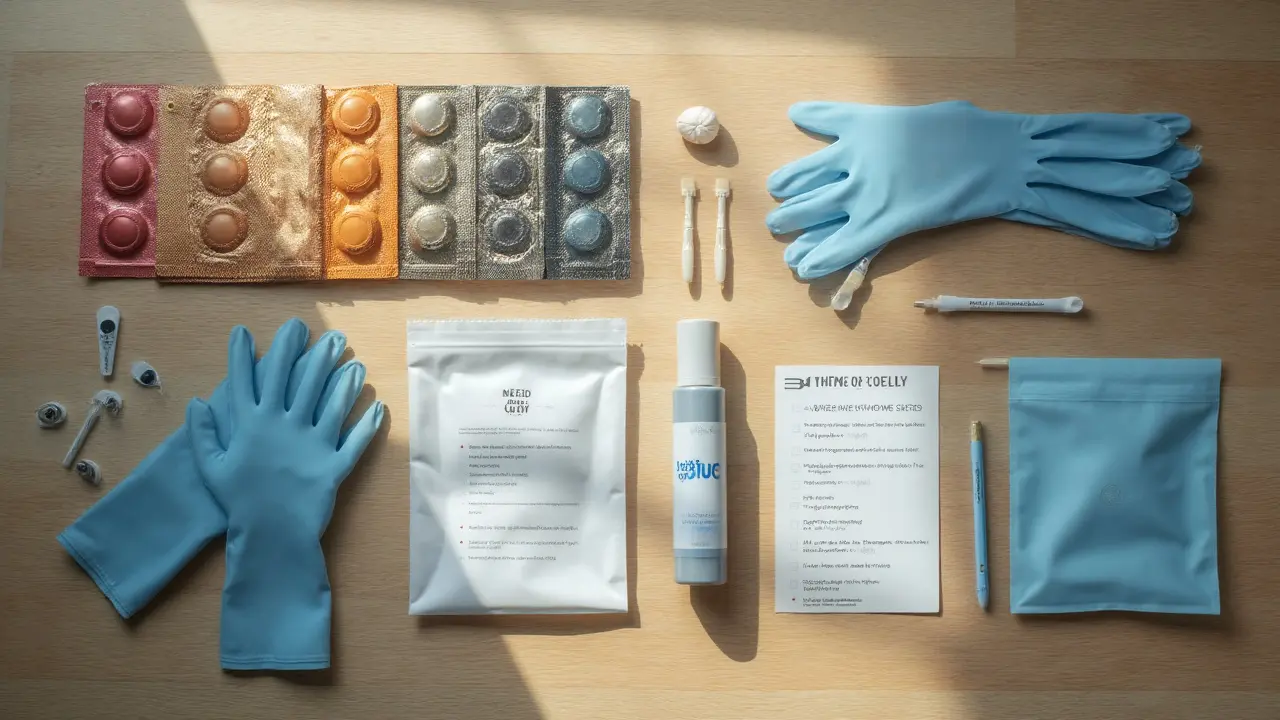Here’s the blunt truth: “Freshie Juice” isn’t magic-it’s body fluids and arousal lubrication doing their normal thing. If you understand where it comes from and what changes it, you can make it taste, smell, and feel better while keeping everyone safer.
Quick basics. Vaginal lubrication comes from two places: transudation (plasma filtering through the vaginal walls) and Bartholin’s glands near the opening. Semen mixes fluids from the prostate and seminal vesicles. Typical vaginal pH sits around 3.8-4.5 (slightly acidic). Semen is usually 7.2-8.0 (alkaline). That pH clash explains why smells shift after sex and why a rinse matters.
Hydration is the easiest upgrade. Dehydration concentrates everything-salts, proteins, and amines-so taste gets sharper and smells linger. Clear-to-pale yellow pee is a decent day-of signal. Aim for steady water across the day, not a last-minute chug.
About the pineapple myth. Yes, sweet fruits and less sulfur-heavy foods can nudge taste a bit for some people, but it’s subtle and short-lived (think hours, not days). Smoking, alcohol, garlic, onions, high-sulfur proteins, and certain meds have a stronger and longer effect on taste and scent than pineapple ever will.
If you’re chasing “fresher,” start with hygiene that doesn’t wreck your microbiome. Skip scented soaps inside the vulva or vagina-they can trigger irritation or yeast issues. Warm water on the vulva is enough; clean the surrounding skin with a mild, fragrance-free soap. For penises, wash the whole area daily; if uncircumcised, gently retract and clean under the foreskin. Post-sex, a quick pee helps reduce UTI risk, and a gentle rinse can clear residual fluids without harsh scrubbing.
Safety isn’t a mood killer; it’s the ground floor. Barrier methods matter because pre-ejaculate can carry STIs and semen changes vaginal pH. Condoms and dental dams are your friends if you want pleasure without surprise lab bills. If you’re sexually active with new or multiple partners, regular screening every 3-6 months is a solid baseline. Remember window periods: chlamydia/gonorrhea show up on tests in about a week, HIV and syphilis can take longer, depending on the test. Talk timing, not just results.
Lube changes everything. Water-based lube is condom-safe, easy to wash, but dries faster-good default. Silicone-based lasts longer and is great for shower play, but it can degrade some silicone toys. Oil-based feels slick but wrecks latex and can mess with the vaginal microbiome-skip if you’re using latex barriers or prone to infections. Flavored lubes can be fun for oral, but pick ones without sugars to avoid yeast flare-ups.
Med check matters. Antihistamines and some antidepressants can reduce natural lubrication. If dryness or delayed ejaculation shows up after a new prescription, ask your provider about options. Meanwhile, use lube like it’s part of the plan, not a last resort.
Want a cleaner taste fast? Brush and tongue-scrape well before play, then rinse-mint gum helps more than mouthwash with alcohol. For bodies, a quick shower and a fresh towel are simple wins. If you’re hopping between oral, vaginal, and anal, change condoms or use new dams each time. That’s not being fussy-that’s how you avoid infections and weird pH drama.
Last piece: consent and pacing. Talk about what you’re up for, what’s off-limits, and what makes you anxious. A 60-second check-in up front saves a lot of mid-scene confusion. Safe, clean, great-tasting “freshness” is mostly about small decisions done consistently, not expensive hacks or viral tricks.
- What 'Freshie Juice' Really Means
- Taste, Smell, and Diet Myths
- Safety, Hygiene, and Testing
- Lube Choices and Practical Upgrades
What 'Freshie Juice' Really Means
When people say Freshie Juice, they’re lumping a bunch of body fluids under one catchy label. We’re talking about natural vaginal lubrication, cervical mucus, pre-ejaculate, semen, and sometimes what folks call squirting. Each fluid has its own source, purpose, and chemistry. Knowing which is which helps you understand taste, scent, and how to keep things comfortable and safe.
Here’s the quick map of where the fluids come from and what they do.
- Vaginal lubrication (arousal fluid): Mostly transudate-plasma that seeps through the vaginal walls when blood flow rises during arousal (vasocongestion). Bartholin’s glands near the vaginal opening add slippery mucus.
- Cervical mucus: Made in the cervix. It changes across the cycle-thin and stretchy around ovulation, thicker and tackier at other times. It’s not the same as arousal fluid.
- Pre-ejaculate (pre-cum): Produced by the bulbourethral (Cowper’s) glands. It’s a clear, alkaline mucus that helps neutralize urine acids in the urethra and adds glide. Volume is usually drops, not milliliters, but it varies a lot by person.
- Semen (ejaculate): A mix of seminal vesicle fluid (about two-thirds), prostatic fluid, and sperm from the testes/epididymis. Typical ejaculate volume is roughly 1.5-5 mL; the World Health Organization’s 2021 lower reference limit is 1.4 mL. Semen is usually alkaline (pH about 7.2-8.0).
- “Squirting”/female ejaculation: Small studies using ultrasound show the bladder fills during arousal and empties during squirting; lab tests often find urine markers plus prostate-specific antigen (PSA) from Skene’s (paraurethral) glands. So, it’s often a mix-mostly diluted urine with a trace of gland fluid.
Chemistry matters because it drives taste and smell. The vaginal environment normally sits acidic (pH about 3.8-4.5), thanks to Lactobacillus bacteria making lactic acid and hydrogen peroxide. That acidity keeps many microbes in check. When alkaline semen enters, pH rises temporarily, which can shift scent until things settle back to baseline.
Volume and feel change with arousal, hormones, and health. Stronger arousal means more vasocongestion and more natural lube. Around ovulation, cervical mucus turns “egg-white” stretchy and more slippery. Low estrogen (postpartum, some birth control, perimenopause/menopause) often means dryness or a thinner, more fragile lining. Meds like antihistamines and some antidepressants can cut lubrication. Hydration plays a role too-dehydration concentrates salts and proteins, which can sharpen taste and smell.
“Is this normal?” A few checkpoints help:
- Color and consistency: Clear to milky white lube is typical. Thick, clumpy “cottage cheese” with itching points to yeast. Thin gray discharge with a fishy odor leans bacterial vaginosis (BV). Yellow-green with burning can mean an STI such as gonorrhea or trichomoniasis.
- pH clues: Simple vaginal pH strips exist. Normal is 3.8-4.5. BV and trich often push pH above 4.5. Yeast usually doesn’t change pH.
- Semen notes: Fresh semen is usually whitish to gray and turns more liquid within 15-30 minutes (liquefaction). Pink, brown, or persistent yellow can be from blood, infection, or meds-worth a medical check if it repeats.
How to tell fluids apart in the moment?
- Arousal lube shows up with touch, kissing, or fantasy and spreads easily. It’s not sticky after it dries.
- Cervical mucus stretches into a long thread between fingers near ovulation; outside that window it’s shorter or crumbly.
- Pre-ejaculate appears as a clear bead at the tip of the penis before orgasm; it’s slippery but minimal.
- Semen arrives at orgasm, thicker at first, then thins. If it’s mixed with vaginal fluids, expect a creamier look.
- Squirting is usually a sudden gush with volume, often during intense stimulation; it’s more watery than semen and can be odorless to slightly urine-like.
Why this breakdown helps: different fluids have different STI risks, cleanup needs, and effects on comfort. Pre-ejaculate can carry STIs and sometimes sperm. Semen’s alkaline pH can irritate some people’s skin or shift the vaginal balance, especially if BV is lurking. Arousal fluid itself is low risk but still mixes with whatever else is present.
Actionable tips if you want things to feel fresher and smoother:
- Match barriers to goals: condoms/dental dams limit mixing of acidic vaginal fluids with alkaline semen, which can reduce post-sex odor shifts.
- Use lube for comfort: even with lots of natural lube, a good water- or silicone-based product cuts friction and microtears.
- Keep the microbiome happy: avoid douching and scented internal products; they disrupt Lactobacillus and can invite BV.
- Watch patterns: if odor or discharge changes after new partners, a medication change, or a period of stress, consider STI screening or a check-in with a clinician.
The headline: this isn’t mystery goo. It’s normal physiology-blood flow, glands, and microbiology doing their jobs. Once you know the sources and chemistry, you can steer taste, scent, and comfort with simple choices instead of guesswork.
Taste, Smell, and Diet Myths
People love the idea that a single fruit or supplement can make everything taste amazing. Reality check: the biggest movers of taste and smell are hydration, pH changes, the microbiome, smoking/alcohol, and time since last ejaculation. Diet tweaks help a bit, but not like social media claims. If you want fresher Freshie Juice, think small habits done consistently, not miracle foods.
Quick chemistry that actually matters. Typical vaginal pH sits around 3.8-4.5 (acidic), thanks to Lactobacillus making lactic acid. Semen runs about 7.2-8.0 (alkaline). When semen hits the vagina, that pH bump can free up volatile amines (like putrescine and cadaverine), which is why a “fishy” smell can pop up after sex. Condoms reduce that pH clash. A strong, persistent fishy odor-especially with thin gray discharge-points to bacterial vaginosis (BV). That needs a clinician, not perfume or douching.
What drives taste and smell day to day:
- Hydration: Low fluids concentrate salts and proteins, so tastes get sharper and smells stick. Aim for pale-yellow urine across the day.
- Abstinence interval: Longer gaps can raise semen volume and concentration (WHO suggests 2-7 days for semen analysis). More concentrated ejaculate often tastes stronger.
- Smoking and alcohol: Tobacco byproducts and acetaldehyde linger in breath, sweat, and fluids; they also dry out mouth and mucosa, which makes any taste feel harsher.
- Meds and health: Antihistamines, some antidepressants, and decongestants dry you out. Antibiotics and douching can disrupt vaginal bacteria and push odor off course.
Myths vs. facts you can actually use:
- Pineapple and sweet fruits: Fun idea, limited payoff. There’s no solid clinical proof that they sweeten semen or vaginal fluids in a big way. If anything changes, it’s subtle and short-lived (hours). Hydration does more.
- Garlic, onion, and spicy foods: Sulfur compounds and strong aromatics show up in breath and sweat within hours. Many people notice a sharper, lingering taste after a garlicky meal. If you plan oral play tonight, keep these light.
- Asparagus: It’s famous for urine smell because of asparagusic acid metabolites (like methanethiol). It doesn’t reliably change semen or vaginal scent.
- Red meat and high-sulfur protein: Heavier, sulfur-rich diets can make odors feel denser. Lean proteins and plenty of water tend to be easier on taste.
- Coffee: Bitter notes plus mild dehydration = stronger perception. One cup is fine; chain-chugging before a session won’t help.
- Supplements: Chlorophyll and “detox” pills haven’t shown consistent, peer-reviewed benefits for genital taste or smell. Save your money.
Sweat studies vs. sexual fluids: A few studies suggest fruit-and-veg-heavy diets can make underarm sweat smell more pleasant. That’s armpits, not genitals. You can borrow the idea-more plants rarely hurts-but expect modest changes, not a flavor flip.
Microbiome basics you can bank on:
- Lactobacilli help keep vaginal pH low and odor mild. Douching, new sexual partners, antibiotics, and semen exposure can tilt that balance.
- BV often smells fishy and gets stronger after sex. Yeast tends to be bready or “beer-like” with cottage-cheese discharge and itch. Trichomoniasis can smell sharp and show greenish, frothy discharge. Any of these need testing and treatment.
- For many, condoms and skipping scented washes cut odor swings more than any diet hack.
Short-term, practical tweaks (12-24 hours before oral play):
- Hydrate steadily; don’t try to fix it with one giant bottle right before.
- Go easy on garlic, onions, heavy curry, and alcohol until after.
- Light meals with fruit, veg, and lean protein sit cleaner than greasy takeout.
- Brush, floss, and tongue-scrape; finish with a water rinse or alcohol-free mouthwash.
- Shower with mild, unscented soap on the outside only; no internal washing.
- If you’re worried about a post-sex smell shift, use condoms or dental dams to avoid pH clashes.
When to get checked instead of guessing: sudden strong fishy odor, itching or burning, unusual discharge color or texture, pelvic or testicular pain, or a new rash. Diet won’t fix infections. A simple test does.
Bottom line: Taste and smell aren’t random, but they’re not a pineapple lottery either. Hydration, gentle hygiene, a stable microbiome, and smart timing beat viral myths every time.

Safety, Hygiene, and Testing
If you want cleaner taste, fewer infections, and less stress, treat safety and hygiene like part of the plan. When people talk about Freshie Juice, what they really want is comfortable bodies and low-risk play. You get there with smart habits, not perfume or harsh soap.
Hygiene that actually helps (and doesn’t wreck the microbiome):
- External wash only. Use warm water on the vulva; mild, fragrance-free soap on surrounding skin. Don’t douche- it pushes the pH off and raises infection risk.
- Penis care. Wash daily. If uncircumcised, gently retract and clean under the foreskin, then dry.
- Hands matter. Trim nails, remove sharp jewelry, and wash before touching genitals or toys.
- Post-sex rinse and pee. A quick rinse reduces odor shifts from semen’s higher pH, and peeing after sex helps lower UTI risk.
- Barriers between body areas. New condom or dam when switching between oral, vaginal, and anal. That’s how you avoid cross-infection.
- Toys. Use condoms on toys if sharing or switching holes. Clean per material: nonporous (silicone, stainless, glass) with mild soap and warm water; check maker’s guide for boil-safe items. Let toys dry fully before storing.
Barrier basics and lube compatibility (no guesswork):
- Condom materials: latex (most common), polyisoprene (latex-free, stretchy), polyurethane (latex-free, thinner, less stretchy).
- Oil breaks latex and polyisoprene. Skip coconut oil, lotions, or oil-based lube with those. Polyurethane is oil-tolerant but check labels.
- Water-based lube is condom-safe and toy-safe; dries faster but easy to reapply.
- Silicone lube lasts longer and is condom-safe, but can degrade some silicone toys-spot test or use non-silicone toys.
- Flavored lubes are for oral; pick sugar-free to avoid yeast flare-ups.
Vaccines and meds that drop your risk:
- HPV vaccine: advised up to age 26, and up to 45 after a talk with your clinician. It cuts the risk of cancers and genital warts.
- Hepatitis B (and A) vaccines: strong protection; many adults are still unvaccinated-worth catching up.
- HIV PrEP: when taken as prescribed, cuts sexual HIV risk by about 99%. Good option if you have new or multiple partners, or a partner with HIV and an unknown/unsuppressed viral load.
- HIV PEP: emergency option after a high-risk exposure; start within 72 hours, earlier is better, take for 28 days.
- Doxy-PEP: a single 200 mg doxycycline dose within 72 hours of condomless sex can reduce chlamydia and syphilis by ~70%+ and gonorrhea by ~50% in MSM and some trans populations (per 2024 CDC guidance). Talk to a clinician to see if it fits you.
Testing rhythm that makes sense:
- New or multiple partners: test every 3-6 months.
- MSM and transgender women: often every 3 months, especially with condomless sex or on PrEP.
- Women and people with a cervix under 25: annual chlamydia/gonorrhea screening; older with new/multiple partners should also screen.
- Pregnancy: test early, and again if risk changes.
- If you treat an STI: retest in 3 months to catch reinfection.
Know the window periods (when a test can reliably pick up an infection). Testing too early can miss things; if you had a recent exposure, follow up at the right time:
| Infection/Test | Preferred Test | Earliest reliable detection | Notes |
|---|---|---|---|
| Chlamydia (CT) | NAAT (urine or swab: vagina, cervix, throat, rectum) | ~5-7 days post-exposure | Often no symptoms; retest 3 months after treatment to check reinfection. |
| Gonorrhea (NG) | NAAT (urine or swab: vagina, cervix, throat, rectum) | ~5-7 days post-exposure | Test-of-cure for throat infections 7-14 days after treatment; otherwise retest in 3 months. |
| Syphilis | Blood (treponemal + nontreponemal) | ~3-6 weeks | If early test is negative but symptoms or exposure risk are high, retest at 6 weeks and 3 months. |
| HIV (4th‑gen Ag/Ab) | Lab Ag/Ab combo | ~18-45 days | Most positives show by 6 weeks; confirm at 45 days if exposure was recent. |
| HIV (RNA NAAT) | HIV-1 RNA | ~10-33 days | Detects earlier than Ag/Ab; often used for high-risk recent exposures. |
| Hepatitis B | HBsAg, anti‑HBc IgM | ~4-10 weeks | Vaccination prevents most infections; check immunity if unsure. |
| Hepatitis C | HCV RNA; HCV Ab | RNA ~1-2 weeks; Ab ~4-10 weeks | Confirm Ab positives with RNA; consider RNA if recent exposure. |
| Trichomonas | NAAT (vaginal swab or urine) | ~7 days | Often asymptomatic in men; treat partners to prevent ping-pong infection. |
Condom facts worth knowing: with perfect use, condoms are about 98% effective for pregnancy prevention; with typical use, about 87%. Consistent condom use cuts heterosexual HIV transmission by roughly 80% and reduces risk for many other STIs. They also keep semen’s alkaline pH from changing the vaginal environment, which helps with odor and irritation.
Red flags-hit a clinic, don’t Google-diagnose:
- New strong or fishy odor (especially after sex), thin gray discharge, or irritation-could be bacterial vaginosis.
- Thick, clumpy discharge and itching-common with yeast.
- Painful urination, pelvic pain, bleeding after sex, sores, rashes, fevers, or swollen nodes-get checked.
Quick post-play routine (60 seconds):
- Swap or remove barriers, tie-off and trash condoms-don’t flush.
- Pee and do a gentle rinse; pat dry with a clean towel.
- Clean toys (soap + warm water), air dry, store separate from linty fabrics.
- Make a quick note in your phone of the date/partner so testing timing is easy later.
And the talk? Keep it simple: “I test every 3 months-last panel was in July, all clear. I use condoms for piv and a dam for oral, and I’m on PrEP.” Clarity beats awkwardness. That’s how you keep things hot, safe, and genuinely fresh.
Lube Choices and Practical Upgrades
Pick the right lube and half your problems disappear: less friction, fewer microtears, better condom performance, and cleaner taste. The rest is simple habits-how you apply, reapply, and store it.
Start with the big four types:
- Water-based: Condom-safe, toy-safe, easy to wash off. Downsides: can dry out; some are hyperosmolar and may irritate tissue.
- Silicone-based: Super long-lasting, great for anal and shower play, condom-safe with latex and polyurethane. Downsides: may damage silicone toys; harder to wash off; can stain fabrics.
- Oil-based (coconut, mineral, petroleum jelly): Long glide and cheap. Big catch: not safe with latex or polyisoprene condoms, and can upset vaginal balance. Only consider with polyurethane condoms and if yeast infections aren’t an issue.
- Hybrid (water + silicone): Tries to give you the best of both. Usually condom-safe. Check toy guidance; many brands say avoid with silicone toys.
Condom and toy rules you don’t want to learn the hard way:
- Oil breaks latex and polyisoprene. It’s fine with polyurethane condoms, but read the label.
- Silicone lube can soften or cloud some silicone toys. If the toy maker says “no silicone lube,” believe them. When in doubt, patch-test on the base.
- Water-based is the safest bet for most toys and all condom types.
Two specs matter more than the marketing: pH and osmolality. Tissue likes lube that matches its environment, and it hates lube that pulls water out of cells.
| Parameter | Vaginal target | Anal/rectal target | Why it matters |
|---|---|---|---|
| Native pH | 3.8-4.5 | ~7.0-7.4 | Keeping near native pH supports healthy flora and less irritation. |
| Lube pH (preferred) | ~3.8-4.5 | ~6.5-7.5 | Closer to site pH = less burn, better comfort. |
| Osmolality (WHO advisory) | ≤1200 mOsm/kg (ideal ~250-400) | ≤1200 mOsm/kg (ideal ~290) | Hyperosmolar lubes can damage the lining; iso-osmolar is gentler. |
| Latex condom + oil | Not compatible | Not compatible | Oils degrade latex and polyisoprene; use water or silicone-based instead. |
Those numbers aren’t trivia. WHO and partners issued guidance that water-based lubes at or under 1200 mOsm/kg are safer for mucosa. Many drugstore water-based lubes are above that, which can mean sting or dryness for some users. Brands don’t always list osmolality, so email support or pick products that state “iso-osmolar.”
Ingredients to watch:
- Nonoxynol-9: Avoid for anal, and avoid frequent vaginal use. It can cause microtears and raise STI risk with repeated use. The FDA requires a warning label for anal use on N-9 products.
- Sugars (sucrose, honey) and high glycerin/sorbitol: Can feed yeast. If you’re prone to yeast infections, go glycerin-free and sugar-free for anything that goes vaginal.
- Benzocaine/lidocaine “numbing” lubes: Numbness can hide injury. Use only if you know why you need it and keep it light.
- Chlorhexidine and heavy fragrances: Common irritants for sensitive skin.
How to choose fast, without getting lost in the aisle:
- Match the job: Oral play-flavored, sugar-free water-based. Vaginal-pH 3.8-4.5, iso-osmolar if possible. Anal-thicker silicone or thick water-based; iso-osmolar wins.
- Match the gear: Latex or polyisoprene condoms-no oils. Silicone toys-prefer water-based.
- Check the label: Look for pH listed near target, “glycerin-free” if prone to yeast, and no N-9.
- Patch-test if sensitive: A pea-sized dab on inner forearm for 24 hours. No redness or itch? You’re likely fine.
Application tips that change the game:
- Use more than you think. Start with 2-5 mL (about a half to one teaspoon) and reapply as needed.
- For condoms: Add a small drop inside the tip before rolling on, then a thin coat outside. Avoid flooding-too much inside can make it slip.
- Water-based drying out? Add a spritz of water to re-wet instead of piling on more product.
- Anal play has zero natural lubrication: Think generous. Plan to top up every few minutes with water-based, less often with silicone.
- Warm it safely: Place the sealed bottle in a mug of warm (not hot) water for a couple of minutes. Don’t microwave the bottle.
Hygiene and storage so your lube stays clean:
- Choose pump or flip-top bottles over screw caps; fewer chances to contaminate.
- Don’t dip fingers into tubs. If you must, use a clean spatula.
- Store cool and dark. Heat speeds breakdown. Respect the expiry date-preservatives don’t last forever.
Quick clean-up plan:
- Water-based: Rinses off with water. Easy on sheets and clothes.
- Silicone-based: Use a bit of mild soap or an oil cleanser on skin, then rinse. Pre-treat fabrics with dish soap before washing.
- Oil-based: Wash skin with mild soap; expect more laundry work. Again, never with latex or polyisoprene condoms.
Budget and convenience upgrades:
- Single-use packets for travel or play parties-clean and no bottle leaks.
- Refillable pump by the bed or shower for one-handed use.
- Thickener hack for water-based: A drop of water-based gel can “anchor” runny lube so it doesn’t drip everywhere.
One last tie-in to taste and smell. Clean, pH-smart lube helps body fluids feel and taste more neutral, which makes your Freshie Juice experience smoother and less distracting. The goal isn’t fancy-just science that keeps play comfy, safe, and easy.




